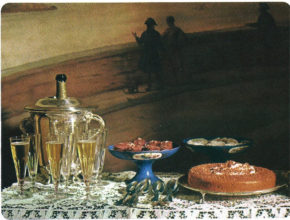“High Tea. This is really the evening supper… …although sometimes the “high tea” is spread for an earlier hour than supper, say seven or eight o’clock. The ladies come in visiting costume and the gentlemen in the morning dress in country towns. In cities, sometimes, dress coats and light gowns are considered essential. Guests are expected to spend the evening. Where there are two rooms such as dining-room and parlor, or two parlors, the tables can be lain in one room, while the guests are assembling in the other. Often, however, the hostess can command but one large room in which to entertain her friends. In this case, the little tables can be brought in by a servant and spread in the presence of the guests without the least breach of propriety. After the meal is over, the dishes are quickly carried out on trays and the tables either taken from the room or left where they stand for cards or any of the many pencil-and-paper games that are pleasant at such gatherings.”
Social Etiquette or Manners and Customs of Polite Society by Maud C. Cooke 1896
You’ve probably heard by now…. High tea isn’t the nice one. High tea refers to the high table that working class people served their tea meal on. It was a hearty meal and not at all what we think of as “High Tea”. Low tea was served on a low tea table made specifically for that purpose. Obviously, people with the kind of disposable income to afford special furniture for a mid-day meal and who had the space for said table, weren’t poor – so low tea is the bougie tea.
Sadly, it was likely us Americans who mixed this up and by the above description of the High Tea in Social Etiquette it’s easy to understand why. That is an convoluted version of tea or evening supper if I ever heard one. Even more amazingly, in the US, turn of the century high tea rarely actually contained tea! Ms. Cooke continues:
“The word tea, by the way, is something of a misnomer, as at these entertainments the beverages are almost invariably coffee or chocolate, or both, tea being left entirely out of the question.”
So, what is the occasion that we all enjoy, with scones and cakes and pretty china? Well, there are two kinds of Formal Tea, the in-home formal tea for a smallish number of guests and the Tea Reception, which was usually out of the home, but could sometimes be held at a private residence for larger groups. I’m going to cover the Tea reception in a later post, here I’m going to talk about the in-home tea, otherwise known at Five O’clock Tea or “At Homes”.
“Through two generations the idea of the afternoon tea has been perfected, until to-day we have cosy, delight, ceremonious five-o’clock teas that are the pride of the English and the joy of everyone who follows the custom. And so we find the afternoon tea enjoying a vogue of unrivaled popularity here in America. When a debutante daughter is to be introduced to society, the mother plans an elaborate afternoon tea (and they can certainly be elaborate!). When guests from out-of-town are visiting, the hostess can think of nothing more appropriate than a chummy tea to introduce them to her friends. So charming a way of entertaining is the afternoon tea that it has usurped the evening reception almost entirely, except when the occasion requires special formality.”
Book of Etiquette by Lillian Eichler, 1922
“Teas are given to introduce a friend, a guest, or a person of prominence, or to extend hospitality to one’s friends by an afternoon “at home”. The usual hours are from three to five. Guest remain for only fifteen to thirty minutes unless some entertainment is provided.”
Practical Cookery and The Etiquette and Service of The Table by the Dept. of Food Economics at Kansas State, 1939
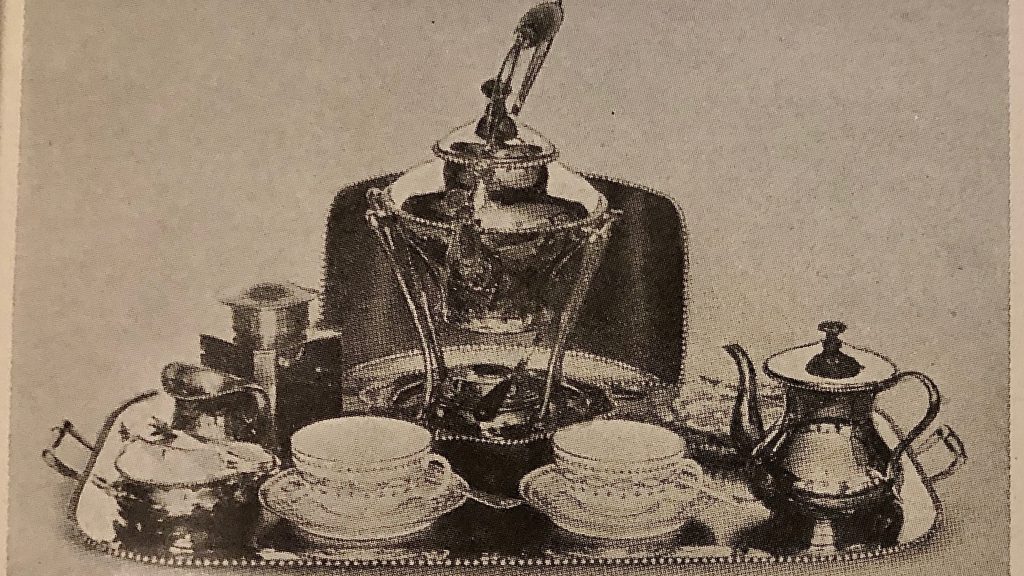
Back when there was no instagram or email, to say hi to your friends and keep up with the latest goings on, you had to show up at their house. While it may seem insane to us now to prepare a tea for guests who were planning to stay only fifteen minutes, you have to remember that ladies who were, “at home” received a parade of guests all afternoon and the guests might be visiting multiple houses in a day, (there are letters describing visiting eight or nine in an afternoon). It would have been very poor manners to monopolize a hostess or guest of honor for longer than a few minutes. This is one of the reasons we see the foods that we do at a formal tea. If you were going to be expected to take a cup of tea and eat a bite at a half dozen homes, a small crustless sandwich at one, a scone at another would be more than enough.
“A pretty little table. Upon it, choice flowers, delicate cups, sugar-basket, tea-caddy and ball, little spoons, wafers, sandwiches, salted almonds and bon-bons, in their lovely dish; at the side, a kettle swinging and singing in its wrought-iron standard, a sweet, gracious woman presiding at the tea urn, and with its guests coming and going – this is a “five o’clock”
Table Talk Magazine, March 1892
Five O’Clock tea was similar to the “at home”, but started around, you guessed it… five o’clock. This was slightly more formal, with some attending in tea dresses, but others dressed for dinners or parties. People still stayed no longer than a half hour, though sometimes hostesses would provide games and entertainments which might entice guests to stay longer. The food at these was fancier, but also lighter as they were in close proximity to the dinner hour.
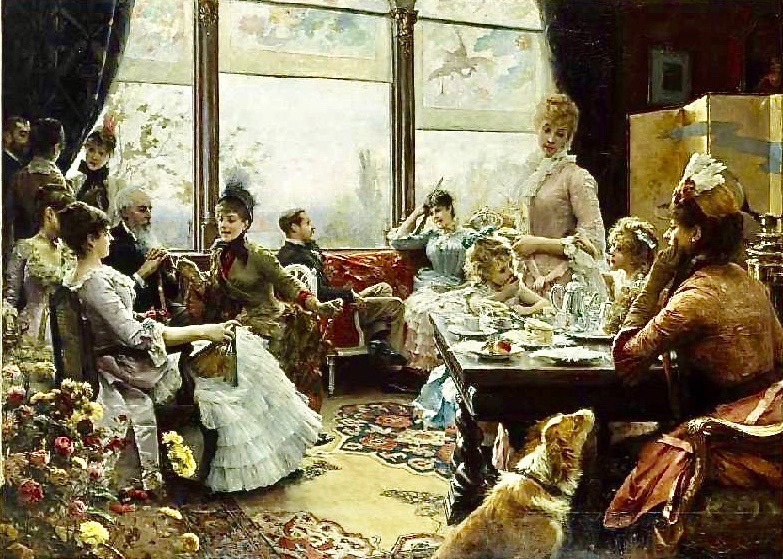
Modern tea goers expect sandwiches and scones to be the equivalent of a meal and dessert, which is why we now serve multiple sandwiches, scones, cakes and even mini savory foods. No one is leaving after fifteen minutes or a half hour, so the food has become more substantial. Yet, the spirit of the meal dictates that whatever you serve is delicate, so abundance replaces heaviness.
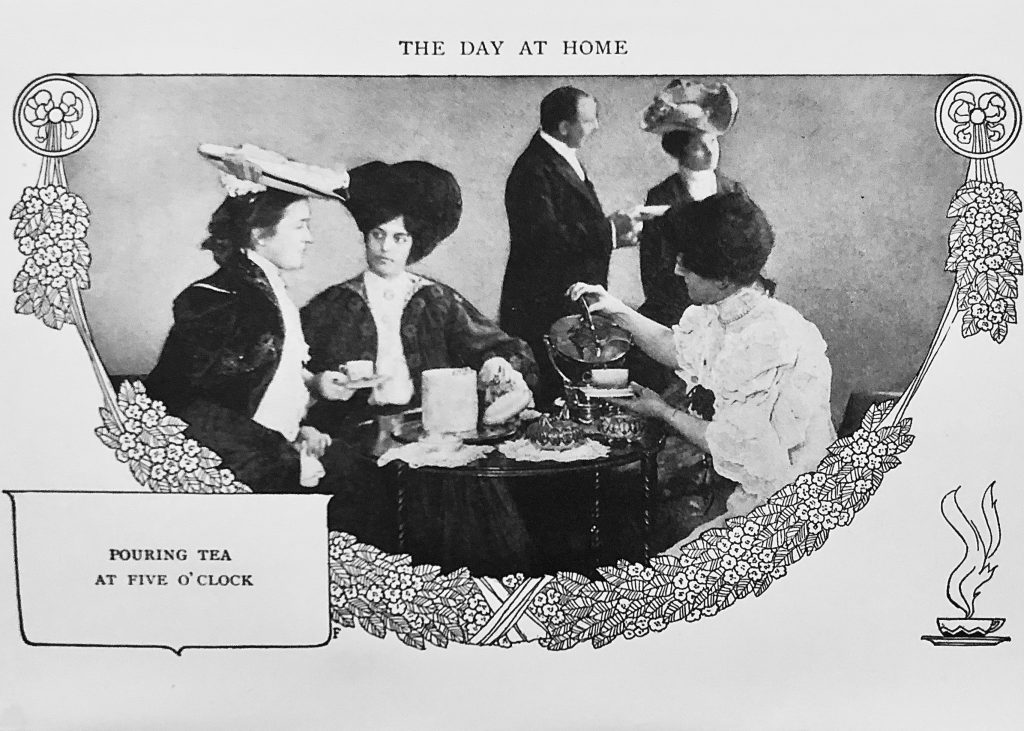
“Formal tea at home is served on a small low tea table with a properly sized tablecloth on it, a tea pot, creamer, sugar, slop bowl, hot water pot over a burner, tea cups, saucers, tea spoons, tea napkins. Cake plate and sandwich plate, tea napkins and serving utensils. Beginning with the table itself, it may be a small oval, circular or hexagon shape. Any one of these is preferable to a square one. if the surface of the table is highly polished and it is preferred not to cover it entirely, a handsome square or round centerpiece doily, which is only a dinner centerpiece, is used, or a teacloth a yard square may prettily and wholly veil it.”
Social Etiquette by Maud C. Cooke, 1896
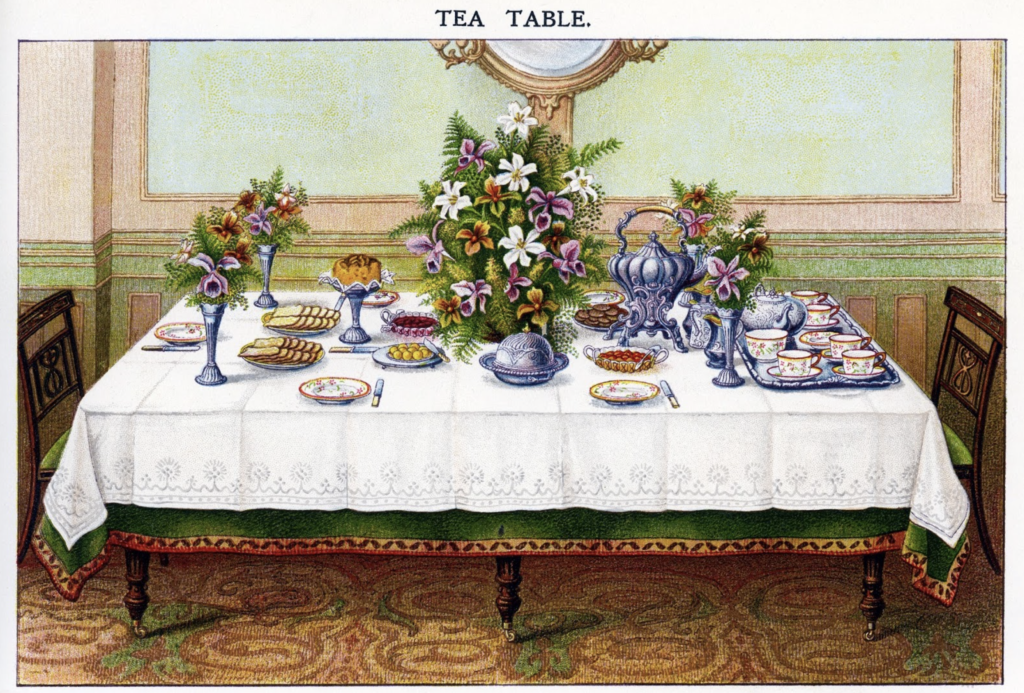
My grandmother said that tea should never be served at the dining table unless it is at a tea reception or for a very large group. You either sat in the parlor or near a table specifically designed for tea. I must admit, I prefer tea sitting in a comfy chair. It somehow ruins the idea that tea is a relaxed and conversational form of entertaining to place it in a too uptight setting, but not all of us have a parlor or a tea table at the ready. If that’s so, arrange your tea things on the dining room table and then let your guest sit comfortably in your sitting area. If you must serve and drink your tea in the dining room, make sure it is as tranquil and comfortable as possible.
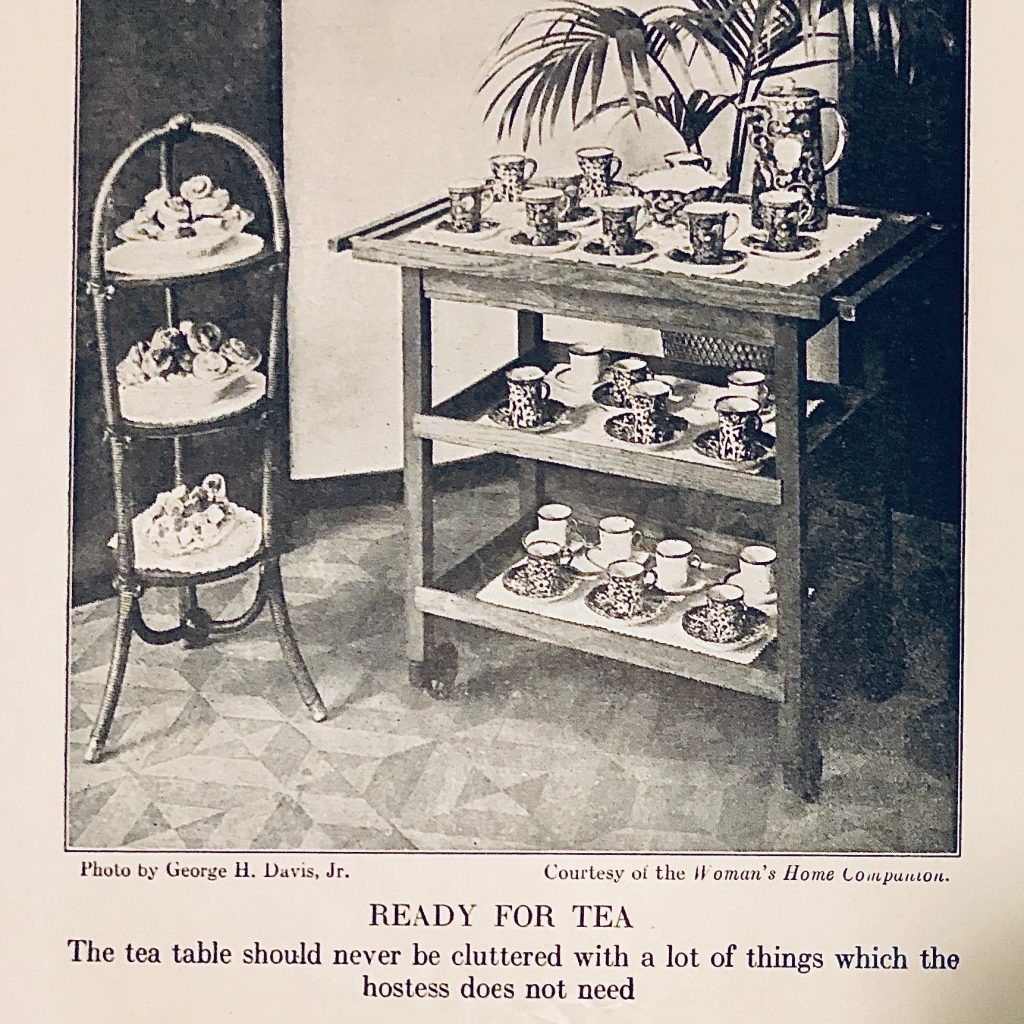
Snob tip: the use of tiered cake plates was begun in tea houses, not in the homes of the fine ladies who served tea to friends. Snobs will prefer silver cake and sandwich baskets with handles. These were developed for easy serving by servants who would bring in the nibbles and add them to the tables. If you want big snob points bring on the baskets and leave the tiers in the cupboard.
Now, I do like a cake basket. They’re really pretty, but they require liners or doilies and are best suited to small tea parties with a limited number of guests. I will use a tiered server for larger parties as they put everything in view of your guests and encourage self-service. They also add height and drama to a table scape. And before the snobs get too out of hand, by the 1930’s one can see very nice tiered sterling silver tea stands in fine catalogs, so they had moved into posh residential settings. It really is personal preference.
If you do happen to possess a cake basket, remember that when cloths cover scones and rolls, people are less likely to reach in and take them, so using baskets in a small group where you can encourage people to help themselves or serve them personally, is best. This is also true of uncut cakes. Many people hate to be the first person to cut into a cake, so you’ll do well to pre-slice tea cakes and arrange them nicely unless you are serving everyone yourself.
In Social Etiquette, the author extolls that, “To measure the tea with a spoon is not considered quite so correct and so redolent of the old-time flavor as to use the cup-cover of the caddy, “one fill to a brew.” That was in 1896, but it is only a few years later that specialized tea caddy spoons were ubiquitous and no one filled the pot with the cup-cover. I must try this some time to see what the “old-time flavor” was!
For a Formal tea, the snob class says ladies should wear a tea/afternoon dress with gloves and a hat. You keep the hat on during the tea, but you remove your gloves. The gloves remain on your lap with the napkin placed over them. In many places, it’s perfectly acceptable to place your gloves in your purse if you’re keeping your purse with you, just don’t put your purse on the table. We’re not all snobs and most people don’t often wear hats or gloves, so if you throw a formal tea, don’t expect guests to buy accessories just for your tea. But, if you are invited to a formal tea, please do try to dress up for the occasion, it’s just common kindness as the hostess will probably have gone out of her way to make it special for you.
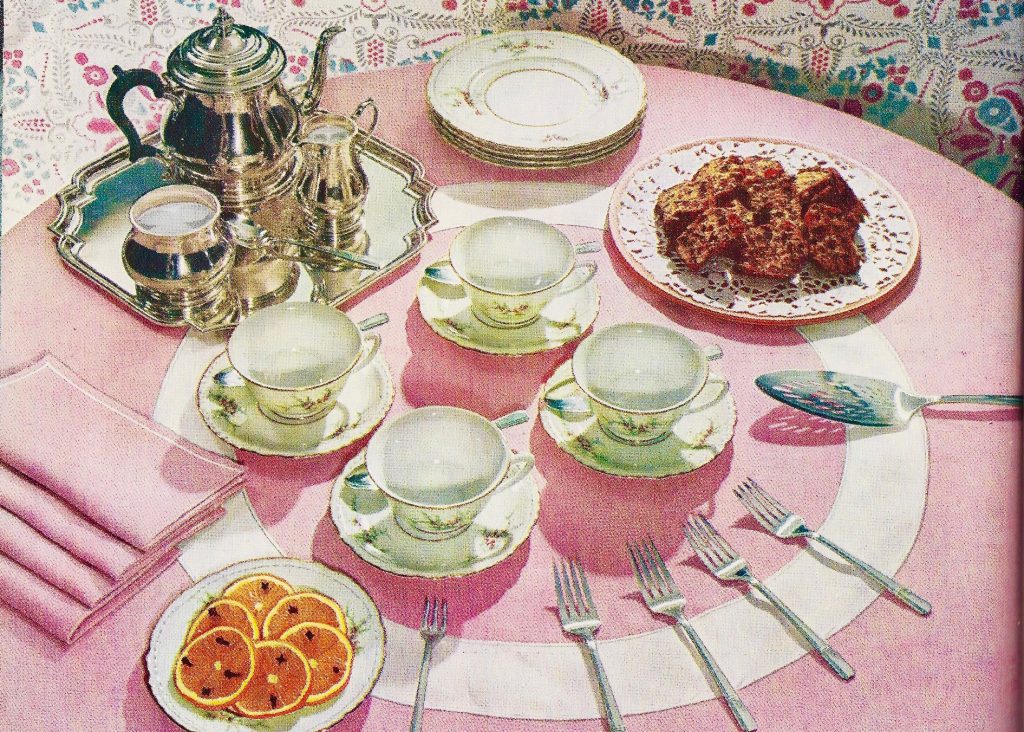
Some snobs will tell Americans to pronounce “scone” as the British do. I think this is incredibly rude. Putting on an accent to please someone else is as much an affectation as raising your pinkie finger. I’ve never met a reasonable British person who corrected me in pronouncing a scone as I would at home, but there are some out there who disagree I’m sure. Other snobs will tell you that there is an order to putting on clotted cream and jam. There really isn’t. The only rule is to put the cream and jam onto your plate first, split your scone and then put your toppings on. Last snob comment: snobs will judge you if you sandwich your scone. I’m going to agree this one. The width you have to open your mouth to eat two halves of a scone with filling won’t be pretty to watch for your fellow guests and if modern etiquette is about anything, it’s about being kind to your fellow humans.
Finally, if you are served tea at a high table, you pick up only the cup and leave the saucer. If tea is at a low table, you pick up the cup and saucer.
Next time, we’ll look at the tea reception.

